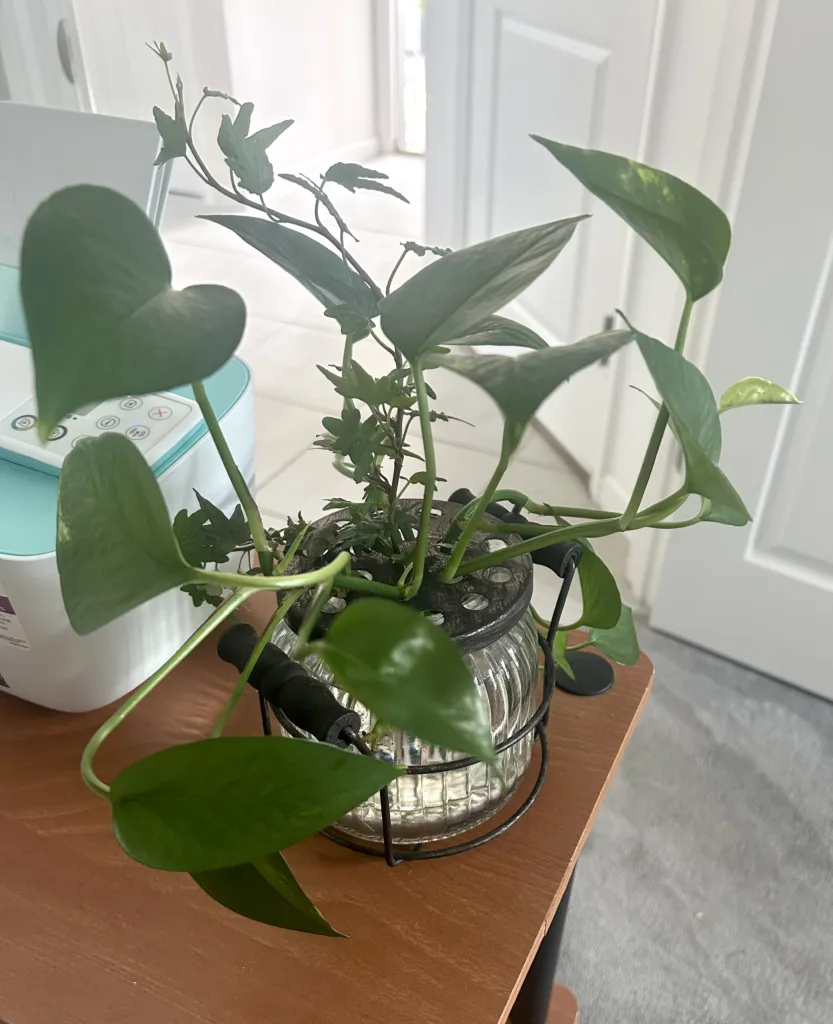Whether you’re a seasoned plant enthusiast or just starting your gardening journey, the pearls and jade pothos is a plant that you should definitely add to your collection. This gorgeous vining plant with its striking variegated foliage is a favorite among gardeners for both indoor and outdoor spaces. Besides its aesthetic value, these beautiful plants are incredibly easy to care for, and beginner gardeners will especially love it. However, before you start growing pearls and jade pothos, read this blog post that covers everything you need to know to grow and care for these stunning plants.
Best Pot Type for Pearls and Jade Pothos
The pot you choose for your pearls and jade pothos needs to be big enough to accommodate the plant’s growth and also need to have sufficient drainage holes. Using a pot with lack of drainage holes can cause root rot. Therefore, make sure to choose a pot with holes so that excess water can easily drain out.
Soil Type for Pothos
The pearls and jade pothos can grow in any well-draining potting soil. However, it thrives best in a soil that is rich in nutrients and holds water well. A blend of peat moss, perlite, and compost works well for these plants. You can also add a small amount of sand to increase drainage.
Light Requirements
As a tropical plant, the pearls and jade pothos prefers bright indirect light but can tolerate low light conditions. Direct sun can scorch the plant’s leaves and cause discoloration. Therefore, placing the plant near a bright window with indirect sunlight is ideal. If you don’t have the perfect window with indirect sunlight then an LED grow light works perfectly.
Water Requirements for Pearls and Jade Pothos
Like most houseplants, the pearls and jade pothos thrives on consistent moisture, but overwatering can also lead to root rot. Water the plant when the top inch of soil feels dry to the touch. In addition, the leaves often wilt when the plant needs water. Don’t wait until the soil is completely dry before watering.
Fertilizing your Pothos
Giving your pearls and jade pothos a regular dose of fertilizer is crucial to keeping them healthy and vibrant. Feed your plant every four to six weeks with a balanced liquid fertilizer during the growing season. However, during the dormant season, feeding can be reduced to once every two to three months.
Propagating Pearls and Jade Pothos
Propagating pearls and jade pothos is incredibly easy, and it’s one of the reasons these plants are so popular among gardeners. You can propagate the plant through stem cuttings or by division. To propagate your plant through stem cuttings, simply cut a 6 to the 8-inch section of a stem below the node and place it in water in a propagation station until the roots form then transfer it into a new pot or you can plant stem cutting directly to the soil. To propagate your plant through division, simply separate the plant into two by pulling the stems apart and planting them in two separate pots.
Growing Pothos in Water Alone
Pothos can be grown in water as well. To do this, you’ll need a glass jar or other unique container filled with filtered tap water. Place your pothos plant in the jar and ensure that all the roots are submerged in the water. Change out the water every 2-3 weeks and fertilize it with liquid fertilizer every month to keep it healthy and growing. I have a variety of pothos in a beautiful vase in my office and love having a plant on my desk.

Happy Gardening!!
Overall, the pearls and jade pothos is a fantastic plant for both experienced gardeners and beginners. This beautiful plant is incredibly easy to care for and has a low-water requirement, making it perfect for those who don’t have a lot of time to spend watering plants. By following our comprehensive guide on growing and caring for pearls and jade pothos, you are now able to successfully grow and propagate these beautiful plants. In no time, you will reap the rewards of a beautiful, vibrant, and healthy plant that will not only brighten up your home or garden, but also bring joy and satisfaction.
Please be sure to check out my Gardening Blog Post Page for more tips on all types of gardening. Including Seed Saving, Seed Starting, Orchids, Water Gardening, Coldframe Gardening, Indoor Bulb Gardening, Hydroponics, Container Gardening, Mums, Herbs, African Violets, planting Bulbs, Flower Gardening, Vegetable and Fruit Gardening, Indoor Houseplants of all kinds, Cactus, Succulents, Hanging plants, Deer resistant plants and even Bird, Bee, Butterfly and Hummingbird Gardens!

